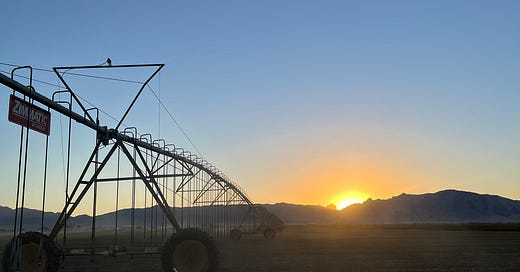maybe Market Conditions are the real innovation arbiters
Prime Future 98: the newsletter for innovators in livestock, meat, and dairy
That is the headline from a recent Wall Street Journal article that goes on to describe an emerging dynamic in this fertilizer-market-gone-wild moment:
This summary highlights two questions that matter when it comes to adoption of anything in ag - whether new technology, new production practices, new marketing strategies. New anything. Let’s call this The New Thing, for simplicity.
The first hurdle is to ShOw Me tHe PrOoF.
Show me the science, the evidence that this has worked elsewhere in a predictable and repeatable way. Producers need highly convicting reasons to believe this New Thing is highly likely to deliver the same results in my operation as it did in the evidence you bring. When you get one shot a year, there’s little room for error.
Assuming the ShOw Me tHe PrOoF hurdle has been cleared, another relevant question is:
Under what market conditions does adoption of The New Thing make the most sense?
And the complexity lies in the fact that 'market conditions' does not simply mean the conditions of a single market. Market conditions refers to the equilibrium of both input costs and commodity prices.
Grain farmers make decisions based on input costs like fertilizer and corn prices.
Cow-calf producers make decisions based on hay prices and drought conditions and calf prices.
Feedyards make decisions based on feed prices and feeder cattle prices and live cattle prices.
Farrow to finish hog producers make decisions based on feed prices and hog prices.
Poultry integrators make decisions based on feed prices and wholesale chicken (meat) prices.
The point is that the unique combination of market factors at any given time can influence adoption in 2 ways:
Increasing or decreasing ROI of The New Thing.Increasing or decreasing the risk of trying The New Thing,real or perceived.
I don’t want to hurt anybody’s feelings but….innovators cannot bend markets to their will. Market conditions are not a controllable, even for highly convicted startup founders creating their own Steve Jobs’ style reality distortion field.
But innovators can be prepared for the market conditions that might create incentives for producers to become more open to trying out The New Thing.
And innovators can think through whether adoption will ONLY occur under certain market conditions (yikes if true) OR if certain market conditions simply give producers a reason to give The New Thing a shot, at which point The New Thing can prove itself in order to become The Status Quo Thing.
Here’s a great quote from the WSJ article, by a farmer currently using Pivot Bio products:
The fertilizer & biologicals situation is interesting because if - under the current combo of fertilizer and grain prices - producers who would not have otherwise had a reason to take on the initial risk (real or perceived) of biologics in lieu of fertilizers now have such a reason, and if biologics prove themselves in yield, then this specific set of market conditions could turn out to be an inflection point for biologics adoption.
The best case scenario is when certain market conditions create a compelling reason to try, and then The New Thing delivers a compelling reason to keep doing the thing even when market conditions normalize.
Of course the flip side is that market conditions can create massive headwinds for The New Thing, in which case for innovators and startups it’s all about staying alive long enough to have the chance at flying in alternative market conditions.
So maybe the takeaway is simply to put your head down and build solutions to real problems, be aware of what market conditions might create a tailwind, and ignore the market chaos while being ready to seize the moment when some ideal combo of market conditions happens.
Sometimes innovation adoption is determined by markets in the form of premiums, discounts, or market access. Sometimes by regulations. But maybe, just maybe:
Market Conditions are the real innovation arbiters.
One last caveat from the classic book Crossing the Chasm on the real challenge of moving beyond innovator customers & early adopter customers to mainstream adoption: everything we’ve discussed here is likely only true for the majority of prospective customers. In the fertilizer vs biologics example, the early adopter farmers were already piloting the use of biologics for other reasons before the market conditions created the opportunity for the rest to consider.
So perhaps the more accurate statement is that Market Conditions are the real ag innovation arbiters for the majority of New Thing adopters.
The unending complexity in ag is what makes it fun...what a time to be alive :)







